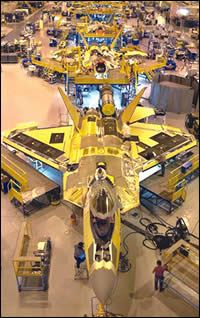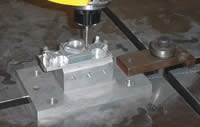Pursuing Lean With On-Machine Inspection
After decades of tinkering with the machined part process, some might consider it nearly impossible to improve on the methodology. Not so, states Michael Angulo, an applications engineer in the Manufacturing Research Division, aeronautics sector at Lockheed Martin Aeronautics (Palmdale, California). The quintessential troubleshooter, Mr. Angulo and a team of quality engineers focused on evaluating the company's manufacturing and dimensional inspection operations, and also on creating a time reduction plan for the machined parts process.
After decades of tinkering with the machined part process, some might consider it nearly impossible to improve on the methodology. Not so, states Michael Angulo, an applications engineer in the Manufacturing Research Division, aeronautics sector at Lockheed Martin Aeronautics (Palmdale, California). The quintessential troubleshooter, Mr. Angulo and a team of quality engineers focused on evaluating the company’s manufacturing and dimensional inspection operations, and also on creating a time reduction plan for the machined parts process.
To successfully introduce technologywithin the company, a tactical implementation strategy was turned into reality via a hands-on pilot program. A goal of process monitoring and tightening process controls to reduce out-of-tolerance conditions was established. If all time-reduction goals were accomplished, then the company would reap improvements in machine repeatability, accuracy, product quality and serviceability.
The Focus Turns to Machined Parts
At Lockheed Martin, gearing up for a production run of quality aircraft parts entails a part inspection plan. Traditionally, if a machined part makes the grade, it moves on to the next process. If the part is rejected, it can be reworked; however, its inherent value is thus reduced by half.
Nothing puts a downward curve on productivity like a long line at the parts inspection door in a manufacturing facility. In a typical inspection scenario, the machine setup is broken down and the part is removed. It is then transported to quality control for a checkup. The process sounds smooth enough. However, on a busy day, people and parts can quickly pile up at the CMM, in turn creating a bottleneck. During this time, those CNC machines are moving on to a different part order with a different setup. If the part does not meet the engineering dimensional requirements, then a rework queue results.
Accomplishing inspection directly on the milling machine could essentially reduce the process times needed to break down part setup and move on to inspection, the company hypothesized. Mr. Angulo says he projected that the company could achieve a 25 percent reduction in lost time as a result of this on-machine probing and inspection.
Deploying the on-machine inspection solution began with the installation of Metrolosys software from Shadow Automation, Inc. (Chino Hills, California) to be used with a five-axis CNC machine tool. The software was developed to essentially transform any ordinary machine tool into a CMM, says the manufacturer.
Capable of being integrated with MasterCAM from CNC Software (Tolland, Connecticut), Metrolosys software works in tandem with any CNC milling machine that has a tool touch probe. The program enables manufacturers to implement a quality process directly on the shop floor that is bi-directionally delivered and controlled by the QA/QC department to perform on-machine inspections on-the-fly. According to Shadow Automation, this new approach to inspection enables manufacturers to capture critical errors such as errors in design, CNC programming or setup upstream in the process.
With Metrolosys, users can generate full Geometric, Dimensioning and Tolerancing (GD&T) inspection procedures using Dimensional Measurement Interface Standards or DMIS 5.0 programming language in the background, all while creating probing motion G code. Probing data can be manually or automatically collected, and the collected 3D data can be compared to an imported CAD master model or a user-defined CAD model to generate GD&T inspection reports directly from the CNC machine tool touch probe. Another residual effect is that the machine tool (with its larger area) can actually measure much larger parts than a conventional CMM.
The technology foundation for the Lockheed pilot program included two networked workstation computers, Pentium-class desktops, Windows 2000 OS, CNC-6000 machine tool controls from AGFM (Chesapeake, Virginia) and a volumetric laser calibration system from Optodyne(Compton, California), which was supplied by the contractor.
A critical phase of the time reduction benchmark involved the on-site installation and testing of a designated five-axis CNC machine tool, with travels of 395 inches by 80 inches by 43 inches (in the Lockheed Martin plant).
The volumetric compensation of the laser was performed after the setup of the machine tool. This process uses off-the-shelf software, computer hardware, laser gages and mirrors that run independently from the machine control. Optodyne’s laser system is driven by a CNC G-code program produced by Metrolosys.
Laser gages interface with a stand-alone computer to track the motion, and the software records the position and repeatability of the motion. Once this is completed, a multi-dimensional array of compensation factors or errors in the motion are captured and recorded. If needed, this information can be used by the software to probe parts that are later produced using the machining center, thus reducing measurement uncertainty. Once the laser measurement process was completed and the results were analyzed, the machine tool was certified by the company’s calibration laboratory.
The networked workstation computers were initially dedicated to creating and maintaining the program’s inspection motion, as well as to creating the final GD&T reports. The participating Lockheed quality inspector and the machine tool operators worked as a team, and they were trained to use the on-machine inspection software and probing equipment. The operators performed a range of hands-on tasks, from creating and defining the probing sequence to post processing the file needed to run the sequence. The team has now performed machine probe inspection on more than 90 production part programs using the process—a landmark in the project.
Setting A New Standard
The benchmark has since become standard practice at Lockheed Martin. The on-machine inspection process has addressed two out of seven critical factors in achieving lean manufacturing. First, the time reduction plan avoids transportation to the CMM and eliminates the old QC queue. Secondly, the process reduces setup times on both ends. Moving inspection to the machine tool earlier in the machined part process results in better parts, says the company.
“Given the magnitude of the benchmark, this type of pilot program requires a high level of cooperation between tooling, design, CNC programmers and quality control inspectors to initiate a quality inspection program that introduces new concepts,” explains Mr. Angulo. “The focus must be on the end result. Based on the success of the program, we will make on-machine inspection a part of any factory acceptance for machine tools, so we will not have to integrate the process at our factory.”
Today, three CNC machines are running 24/7 with on-machine inspection capabilities. The machinist now downloads the NC program and probes data points of a part within a tolerable timeframe, with future plans to produce his/her own inspection report. If there are no exceptions to the report, then the part proceeds to the next step. The inspection backlog is expected to be reduced. As long as the cutter does not break, parts are moving on down the production line.
With the initial phase of the time reduction plan completed, the company is building on this foundation and looking for continuous improvement and efficiency in its processes. The quality team is now working with machine tool manufacturers to ensure that the controllers are better attuned to the on-machine inspection process.
Mr. Angulo and his team of quality engineers, with integration assistance from CAD/CAM Consulting and Shadow Automation, have pioneered a new chapter in lean manufacturing, and the dividends are tangible. The time-reduction program at Lockheed Martin-Palmdale has reduced the variability of the machine process. In the end, the program has also fostered a better understanding of the processed product quality.
Read Next
3 Mistakes That Cause CNC Programs to Fail
Despite enhancements to manufacturing technology, there are still issues today that can cause programs to fail. These failures can cause lost time, scrapped parts, damaged machines and even injured operators.
Read MoreThe Cut Scene: The Finer Details of Large-Format Machining
Small details and features can have an outsized impact on large parts, such as Barbco’s collapsible utility drill head.
Read More














.png;maxWidth=300;quality=90)



.png;maxWidth=300;quality=90)





